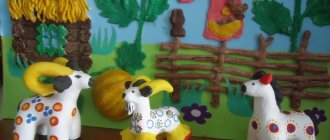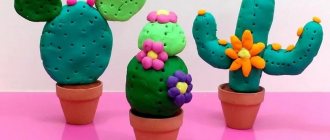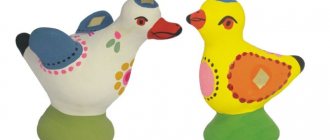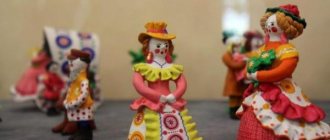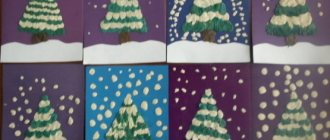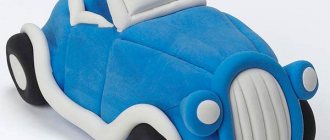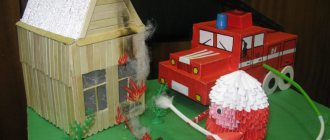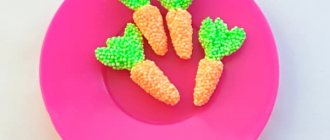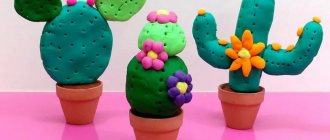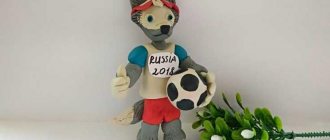In this article you will find many ideas for modeling from plasticine with step-by-step instructions and photos, as well as what crafts you can do with a child at different ages.
Working with plasticine has a beneficial effect on a child's development. These activities improve memory, attention, have a good effect on thinking, develop fine motor skills of the hands, which in turn contributes to the development of speech, form the imagination, open up creative abilities, and force one to exercise imagination. You will learn more about the benefits of practicing with plasticine and other materials in the article Let’s sculpt with children from plasticine. Plasticineography
Is plasticine necessary for children under one year old?
It is recommended that children engage in modeling from the age of 1; until the child is one year old, the child will most likely show no other interest in plasticine other than trying it out. But children are all different, so you can try modeling with your child earlier. Show your baby plasticine of one color, tear off a piece of it, roll the ball, let him hold it in his hands. If the child is not interested, put it aside and try again after a while.
For small children, it is best to use soft plasticine, for example, or better yet, prepare your own salt dough. Read about salt dough and crafts made from it in the article DIY salt dough crafts. Crafts for the holidays
Clay or plasticine?
Undoubtedly, clay crafts are more durable, but there is also more hassle with clay. This includes not only washing the young sculptor after work; if you want to preserve the clay product, then it must be fired after sculpting. Plasticine leaves virtually no marks on your hands, does not require firing or coating after completion of work, and can also be reused.
Modeling from plasticine for children 2 and 3 years old
At the age of 2 to 3 years, a child still cannot cope with ordinary plasticine, so it is worth choosing special soft plasticine for small children.
Children are still learning to control their hands and it is difficult for them to practice modeling. Select tasks that are not difficult for your child so that he can cope with them; this will inspire him, give him self-confidence and he will want to continue to engage in this useful type of creativity.
By the age of three, a child will already be able to:
- tear off pieces from plasticine
- make balls out of them
- flatten them
- stick plasticine to paper and smear it
- crush the balls with your palms
- make sausages
- twist them into rings
- combine all the components into one craft.
The parents' task is to teach their child this.
Show your child
- how to cut a sausage and get rings
- how to cut out figures from flat cake
- how to cut dough into squares, triangles and other shapes
- how to stick various objects onto plasticine smeared on cardboard, for example, seeds, beads, cereals, pasta
The duration of a modeling lesson at the age of 1-3 years is 5-15 minutes and depends on the child’s mood and desire to work with plasticine.
For this age, it is recommended to use plasticine only in primary colors, so as not to overload the child with a large variety and not distract from the modeling activity itself. In addition, if desired, colors can be mixed and new shades can be obtained.
Useful tips
High-quality plasticine must have the following qualities:
- Do not stick to your hands;
- Easy to warm up;
- Do not paint your hands;
- Do not leave greasy marks;
- Do not crack;
- It's good to stick to each other;
Understanding what can be molded from plasticine for beginners, you can learn how to create the simplest figures and gradually move on to more complex master classes.
- First of all, young children should be taught to knead, pinch, spank and flatten plasticine.
- It is best to show a child how to sculpt by example.
- Use plasticine from trusted manufacturers with a good composition.
- Introduce your child to different types of plasticine, as each of them is unique in its own way.
- You need to start sculpting with the simplest figures that are recognizable to the child.
- The most important thing is that you should not force your child to sculpt from plasticine if he does not like this activity.
Modeling from plasticine for children 4 and 5 years old
At the age of 4-5 years, a child already skillfully handles a modeling knife, his hands are already stronger and he can work with ordinary plasticine.
Children of this age know how to roll balls and sausages, and now it will be more interesting for them to make more complex and interesting crafts themselves.
Invite your child to make a mushroom meadow or forest lawn with bushes and trees around. Maybe the child will want to make something of his own, don’t interfere with this. On the contrary, this is good and fosters independence.
Also, the mother can sculpt one part of the composition, and the child another, then combine everything into one craft. This way the child will feel responsible for his part of the work.
A child at this age can sculpt simple figures of animals, plants, birds, and food for dolls.
You can begin to master the technique of plasticine printing with your child and make simple plasticine paintings and panels. Invite your child to add natural and waste materials to such paintings.
The time of working with plasticine is 10-20 minutes; if the child is very enthusiastic, it can be extended a little, depending on the child’s perseverance.
Modeling options
There are many different crafts that can be made from materials such as plasticine.
- Animals and birds, as well as snakes and lizards. Sculpting animals is extremely interesting, you can make them simpler or more complex, but the theme of fauna is the most popular of all existing ones.
- Plants and flowers - flora is also relevant in the art of sculpting.
- Food products - it is especially interesting to make various sweets in the form of ice cream, donuts, and candies. This theme is one of the most favorite for many children.
- Themed figurines - New Year's, Easter, birthdays and Halloween, the choice is extremely wide.
Various stacks and spatulas will be useful for work; you can also use decor and even dilute the compositions with natural materials.
Modeling from plasticine for children 6 and 7 years old
You can use regular plasticine or buy different sets, for example, for modeling confectionery products. There are also kits with mass for modeling; they harden well in air and are preserved in the future.
At primary school age, children already know how to independently fantasize and bring their ideas to life. They sculpt more complex figures following step-by-step instructions.
Help your child make a picture from plasticine; he can already make more intricate drawings with a lot of small details, transitions of colors and different textures.
There is no need to limit the time for modeling at this age; let the child do as much as he wants and as much imagination and perseverance as he has.
Master class: Lollipops
Almost all children love candy, so making candies from plasticine will be extremely interesting. For work, you can use multi-colored plasticine.
- Several balls are molded from multi-colored plasticine.
- The balls need to be rolled into thin sausages.
- The sausages are rolled into a spiral; you can use as many different colored spirals as you like in one candy.
Ready lollipops are attached to sticks, the candies are ready.
How to make food for dolls from plasticine?
Soft plasticine is good for creating toy food. It will be boring for the baby to just make balls, but if they are used as decoration for a toy cake, it will be more interesting. You can make various cakes, pasta, sandwiches, pastries and much more with your child, as long as your imagination is enough. You don’t have to throw away the candy boxes, but make your own toy candies for them. Be sure to fit your doll food to the container they will eat it from.
For older children, you can combine the lesson with mathematics, divide the cake into equal parts and study fractions, feed guests and count how many cakes you need to prepare for them.
Below we give you several step-by-step instructions on how to make some food for dolls from plasticine.
Broccoli made from plasticine
Take plasticine in three different shades of green. From the lightest one, make a sausage leg for cabbage, divide it in a stack into several small branches. Take three pieces of plasticine of different shades and press them through a kitchen strainer, and you have broccoli florets. Connect these parts together.
Modeling sausages from plasticine
Prepare sausage-colored plasticine. Make a flat cake out of it, put white stripes on top. Roll the cake, roll it like a sausage between your palms and put it in the refrigerator for a while. You need to cut the sausage using sawing movements, not pushing.
Making ice cream from plasticine
Take a piece of sand-colored plasticine and stamp cells on it, like on waffles. Now make a cone and one or three balls, the same color as you want to make ice cream, you can take different colors. We stick the balls onto the cone to its base, and wrap it with our wafer cake. You can add jam on top by smearing two or three sausages crosswise on the balls, stick small multi-colored pieces and sprinkle with crumbs.
Modeling cheese from plasticine
The cheese is made from yellow plasticine with a small addition of orange. Make a cake, cut out a triangle and press holes in it, it is convenient to make large holes with the back of the pen, and small ones with a writing tip or pencil.
Making a cake from plasticine
Make several plasticine balls of different colors, it is better to take two brown ones for the chocolate layers of the sponge cake, two different berry colors and one of whatever color you want for the icing.
We make chocolate and berry cakes very simply, flatten the ball a little and roll it out into barrels to even them out.
We combine all the cakes into one cake and roll it sideways again to even out all the layers.
We take our icing ball and roll it out as thin as possible, wrap our entire cake in it, cut off the excess edges and smooth it out.
Now we make the cream: roll out the plasticine into a thin and long sausage, fold it in half and twist it. We spread it around the perimeter of our cake.
We cut the cake into pieces and use a toothpick or toothbrush to add porosity to our chocolate layers of the sponge cake. Each piece can also be decorated with fruit beads and topped with glaze.
Bread can be sculpted using sand-colored plasticine. To make a loaf, add toothpick prints to it diagonally.
How to make a watermelon from plasticine?
We take black plasticine and roll several thin sausages. We roll out the red plasticine into a not very thin oval-shaped cake. Place one sausage in the middle and fold the flatbread in half.
Add a couple more sausages and fold them again and repeat this several times. Finally, give it a round shape.
We wrap our watermelon in a white cake, and then in a green one, thus making a peel.
Add lighter colored green stripes.
And cut it. Look how ripe our watermelon turned out!
Thematic
It is possible to create crafts from plasticine on the theme of a cartoon or fairy tale. In this case, the picture serves as a support, which the child must focus on when creating his craft.
If it is quite complex, the child cannot do without the help of parents, but there is no need to do all the work for him. It will be enough to disassemble the craft into several main parts, show him how to create them and assemble them into one whole.
The photo of plasticine crafts shows that cartoon characters, fairy tales, and computer games are used as a basis. At the same time, the design is not always limited to soft material alone. Let's look at how to make a craft from plasticine so that it can take different poses.
Initially, you need to create a skeleton on which the plasticine will be placed. To do this, you will need a rigid wire that bends quite hard.
Ordinary wire will not work, as it is thin and can easily break, and will not hold the desired position.
After creating the skeleton by twisting, you need to create a body by covering it with plasticine.
When the process of creating the body is completed, all that remains is to edit the appearance of the craft, remove excess and add colorful details, giving the product realism.
As a result, you can make a full-fledged figurine with the ability to change the position of your body at any time. As a rule, such crafts are made with the direct participation of adults, because children will not be able to correctly fasten the wire parts in order to obtain the most stable and durable skeleton.
If it is necessary for the structure to be monolithic and durable, it is recommended to make crafts from airy plasticine; it hardens at room temperature.
Modeling a bird from plasticine
Let's blind a parrot. Follow the step-by-step instructions below and you will have a beautiful and talkative bird.
- Take red, yellow, blue, white and black plasticine
- Make an oval body for a parrot from yellow plasticine
- Add a smaller red circle - this will be the head of our bird
- The wings will be blue, to do this, stick two droplets on the sides of the body
- Add a white breast to your parrot
- Make a yellow beak, stick on the eyes and make a crest from the cones
- Let's add another tail and use a stack to push through the grooves on the bird's chest and wings that resemble plumage
- All that remains is to attach the paws and the parrot is ready
This kind of cockerel can be made from plasticine.
This is how a penguin is made from plasticine.
Plasticine painting from flagella
A subject or subject picture with plasticine flagella looks much more realistic than a simple applique. Thin sausages are rolled out from pieces between the palms or squeezed out using a syringe.
The second method is beyond the capabilities of younger preschoolers, so adults make such preparations themselves. And the children twist them into a spiral or snake and glue them onto cardboard.
Craft materials:
- Outline illustration from a coloring book. You can also draw your own design on cardboard by hand or using templates.
- Soft plasticine in the desired colors.
- Medical syringe with a volume of 5–10 ml.
- Container with hot water.
How to sculpt dinosaurs from plasticine?
- Take plasticine of any color, because you can make a dinosaur whatever you want
- Divide a piece of plasticine into three parts, one will go to the head, from the second we will sculpt the body, and the third will be divided into all other parts
- Divide one piece into three more parts, and one of them also into three
- From the two largest pieces we make the body and the head, to do this we roll them into sausages and stretch them out, connect them to each other and align the junction. What you should get is shown in diagram number 3
- Roll the two middle pieces into cylinders and stretch them out a little, flatten them from the bottom and top, leaving a thin “waist” - form the legs as shown in diagram 4
- Make sausages from small pieces - front legs
- Now assemble the figure from what is already ready and smooth out all the joints
- Roll a lot of small balls from the remaining piece of plasticine and stick them, pressing them on the sides, onto the dinosaur's crest.
- Make his eyes and don't forget about his eyelids
- Use a plasticine knife to cut the dinosaur's mouth and open it. Push down the nostrils with a toothpick, trim the paws a little
- Make teeth and claws for our figurine from white plasticine
You can also make such a dinosaur from a pine cone.
And here is another dinosaur - stegosaurus, one of the most popular among children.
If a child wants to make a predator dinosaur, invite him to make a Dimetrodon.
Animals
It is quite easy to mold an animal from plasticine. This option is perfect if the child already needs to get ready for bed, but he is still very active, you need to invite him to make one of the animals himself. This will significantly calm him down, help him prepare for bed and fall asleep faster.
For sculpting, it is advisable to choose plasticine that will not stain clothes and stick strongly to your hands. Additionally, you may need a plasticine knife, which is included in the kit. Let's look at a few plasticine crafts step by step.
How to sculpt a pony from plasticine?
After watching the My little pony cartoon, your daughter will probably want to make the same pony. Let us help her with this.
- Take plasticine of the desired color, pink, purple, red and blue shades are perfect
- Roll a sausage of the chosen color - this will be the body of the pony
- Pull one side of the sausage up into a cone - this will be the neck
- Roll the ball and stretch it out a little, forming the face of a small horse
- Make droplets out of two small pieces and stick them to the top of the muzzle - these will be the ears
- Use a toothpick to press down the pony's nostrils and mouth.
- Roll four cones from plasticine of the main color, cut off a little plasticine diagonally from the narrow side with a special knife, this is where the legs will be attached to the body
- Tap the wide part of the cones on the board to create horse hooves
- Assemble your figurine. Smooth out the joints
- To make the mane and tail, roll several thin multi-colored sausages, connect them together and cut them, stick them to our pony, bend them a little, imitating the curves
- Don’t forget about the eyes, make them not round, but elongated, in the shape of a leaf
Our pony is ready!
You can make several small horses of different colors and you will have many cartoon characters to play with.
You can make a pony in another way, see step-by-step photos below.
Crow
You will need: plasticine, toothpick, glass.
Master Class
- Roll a small ball of dark gray plasticine.
- Roll a smaller ball of light gray plasticine.
- Flatten the light gray ball into a flat cake.
- Make cuts in a circle.
- Cut off pieces of plasticine to make a star.
- Connect the ball with the star.
- Using a round stack, press 2 holes on the ball.
- Make an oval-shaped bird's body from dark gray plasticine.
- Make the wings of the bird in the shape of flattened drops of dark gray plasticine.
- Make a wavy outline on the wings using a stack.
- Attach the wings to the body.
- Make the crow's paws and attach them.
- Make 3 thin little sausages and attach them to the top of the bird's head.
- Make the eyes of a crow from black and white plasticine.
- Draw the eyebrows of the crow in a stack.
- Attach a small tail to the crow.
- Make a toothpick pattern on the raven's neck.
The plasticine raven is ready! I recommend watching this video!
WE MAKE iPhone X - iPhone 10 FROM PLASTICINE | Video Modeling
Crafts from plasticine
Show your imagination and combine natural materials and plasticine in one craft. It will be unusual and interesting for the child.
Making a boat from plasticine and nutshells
- Prepare nut shells, plasticine, leaves from trees, small sticks
- Stick a ball of plasticine into a cleaned shell and place a mast on it - a small stick
- Place leaf sails on the mast and attach another plasticine ball on top
- Launch your boats into the water
Making a caterpillar from plasticine and chestnuts
- Cook some chestnuts
- Roll several colorful plasticine balls
- Connect the chestnuts, alternating them with plasticine, press them down so that they stick firmly
- Make eyes from white and black plasticine
- Add a red balloon nose and a sausage mouth
- Don’t forget about the horns, they can be made from pieces of a match, combined with plasticine with chestnuts
You can also make a hedgehog like this from chestnut peel and plasticine.
These are such cheerful multi-colored snails made of plasticine and chestnuts.
What you need to work with plasticine
In addition to a set of colorful clay, consider a work surface for modeling. To prevent the furniture from deteriorating, you can use a special board for modeling, or replace it with a piece of cardboard, oilcloth, or a regular plastic cutting board.
A spatula for modeling will come in handy when working with a stack. Also having a rough idea of what exactly you will sculpt, you can prepare additional accessories for crafts. These can be natural materials, such as nuts, cones and pebbles, or artificial decorations such as beads, it all depends on the ideas of the authors.
